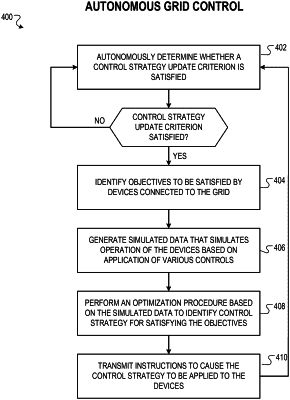| CPC H02J 3/004 (2020.01) [G05F 1/66 (2013.01); G06Q 50/06 (2013.01); H02J 3/14 (2013.01); H02J 2203/20 (2020.01)] | 20 Claims |

|
1. A system for controlling devices connected to an electrical grid, the system comprising:
a manager subsystem that is configured to perform operations comprising, at each time point in a sequence of multiple time points:
autonomously determining whether each control strategy update criterion in a set of control strategy update criteria is satisfied at the time point, wherein the set of control strategy update criteria comprises at least one of:
a first control strategy update criterion that is satisfied if a measured change in an electrical load on the grid exceeds a threshold amount in a time period prior to the time point; or
a second control strategy update criterion that depends on a magnitude of the electrical load on the grid at the time point;
and in response to determining that a control strategy update criterion in the set of control strategy update criteria is satisfied at a time point, updating controls applied to devices connected to the electrical grid, comprising:
identifying: (i) a plurality of devices connected to the electrical grid, and (ii) one or more objectives to be satisfied by the plurality of devices, wherein:
the one or more objectives specify a target load curve that defines a target for an aggregated load generated by the plurality of devices; and
the target load curve: (i) is greater than a baseline load curve over a first target time period, and (ii) is less than the baseline load curve over a second target time period; and
the baseline load curve defines an aggregate load generated by the plurality of devices if the plurality of devices are not controlled to satisfy the one or more objectives;
obtaining current monitoring data that characterizes a current operational state of the electrical grid and of the plurality of devices connected to the electrical grid as of the time point;
providing, to an optimization subsystem, the current monitoring data and data identifying: (i) the plurality of devices connected to the electrical grid, and (ii) the one or more objectives to be satisfied by the plurality of devices, wherein the optimization subsystem identifies a respective control to be applied to each of one or more of the devices to achieve a target operational state of the grid, and provides data identifying the respective control to be applied to each of one or more of the devices to the manager subsystem;
receiving, from the optimization subsystem, the data identifying the respective control to be applied to each of one or more of the devices to achieve the target operational state of the grid; and
transmitting, to a dispatcher subsystem, instructions to cause the dispatcher subsystem to instruct the respective control to be applied to each of one or more of the devices;
the optimization subsystem that is configured to perform operations comprising:
receiving the current monitoring data the data identifying: (i) the plurality of devices connected to the electrical grid, and (ii) the one or more objectives to be satisfied by the plurality of devices;
for each of one or more devices of the plurality of devices:
generating, using the current monitoring data and a model for the device and for a plurality of controls, a plurality of simulated load curves that simulate operation of the device based on application of a respective control of the plurality of controls;
identifying, by an optimization procedure and based on at least the plurality of simulated load curves for a respective device, a respective control to be applied to the respective device of the plurality of devices to satisfy the objectives; and
the dispatcher subsystem that is configured to perform operations comprising:
transmitting instructions to cause the respective control to be applied to each of one or more devices of the plurality of devices.
|